Ants
ODOROUS HOUSE ANT
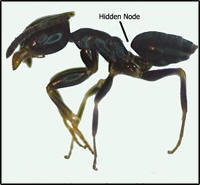 The
odorous house ant is probably the most common
house-infesting ant species in North Carolina. Their
name comes from the odor of rotten coconut that is
noticeable when you crush the insects. Workers are
about 1/8” long and brown to black in color. There
is one node on the pedicel that is hidden by the
overlapping abdomen (see the picture above).
Colonies may contain several hundred to 100,000
workers and contain multiple queens. New colonies
are formed primarily by budding; however, occasional
mating swarms may occur in late spring. Odorous
house ants can nest in many different places.
Outdoor they may build their nests in mulch, in
piles of logs, firewood, boards, and other debris.
They may also nest beneath stones, sidewalks, patio
blocks, and concrete slabs. Indoor nest sites may
include wall voids, window frames, in insulation in
an attic or between bats of insulation and
crawlspace subflooring. Indoors, odorous house the
ants are typically attracted to sugary food items.
Outdoors, they feed on the honeydew secreted by
aphids and other insects on shrubs and trees.
The
odorous house ant is probably the most common
house-infesting ant species in North Carolina. Their
name comes from the odor of rotten coconut that is
noticeable when you crush the insects. Workers are
about 1/8” long and brown to black in color. There
is one node on the pedicel that is hidden by the
overlapping abdomen (see the picture above).
Colonies may contain several hundred to 100,000
workers and contain multiple queens. New colonies
are formed primarily by budding; however, occasional
mating swarms may occur in late spring. Odorous
house ants can nest in many different places.
Outdoor they may build their nests in mulch, in
piles of logs, firewood, boards, and other debris.
They may also nest beneath stones, sidewalks, patio
blocks, and concrete slabs. Indoor nest sites may
include wall voids, window frames, in insulation in
an attic or between bats of insulation and
crawlspace subflooring. Indoors, odorous house the
ants are typically attracted to sugary food items.
Outdoors, they feed on the honeydew secreted by
aphids and other insects on shrubs and trees.
|
ARGENTINE ANT
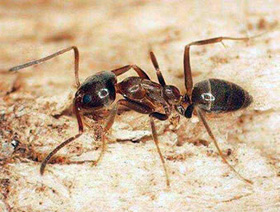 Argentine
ant workers are approximately 1/8” long
and light to dark brown in color.
Originally from South America, this ant
is believed to have entered the U.S. on
coffee ships from Brazil and was first
recorded in Louisiana in 1891. Since its
introduction, the Argentine ant has
become established throughout the
southern states and in California.
Colonies contain multiple queens and are
large and expansive, consisting of many
nests. Unlike many ant species, members
of different Argentine ant colonies are
not aggressive toward one another and
mix freely among nests, permitting
colonies to grow to enormous sizes.
Mulch is a perfect nesting material for
this ant. During the summer, nests
located in soil are usually very
shallow, only 1-2 inches deep. Nests may
be found in all types of piled items,
including lumber, rocks, and other
debris. Wall voids, insulation, and bath
traps may serve as nest sites for this
ant. Argentine ants feed on both live
and dead insects, as well as honeydew.
They may be attracted indoors by many
food types, but prefer sweet foods. Argentine
ant workers are approximately 1/8” long
and light to dark brown in color.
Originally from South America, this ant
is believed to have entered the U.S. on
coffee ships from Brazil and was first
recorded in Louisiana in 1891. Since its
introduction, the Argentine ant has
become established throughout the
southern states and in California.
Colonies contain multiple queens and are
large and expansive, consisting of many
nests. Unlike many ant species, members
of different Argentine ant colonies are
not aggressive toward one another and
mix freely among nests, permitting
colonies to grow to enormous sizes.
Mulch is a perfect nesting material for
this ant. During the summer, nests
located in soil are usually very
shallow, only 1-2 inches deep. Nests may
be found in all types of piled items,
including lumber, rocks, and other
debris. Wall voids, insulation, and bath
traps may serve as nest sites for this
ant. Argentine ants feed on both live
and dead insects, as well as honeydew.
They may be attracted indoors by many
food types, but prefer sweet foods.
|
LITTLE BLACK ANT
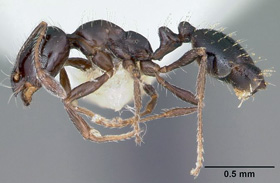 Little black ant workers are very small, about
1/16”, shiny black in color, and slow-moving.
Colonies are moderate to large and contain multiple
queens. New colonies are formed by swarmers which
are typically seen June to August. This ant may nest
in many different places, including in mulch, logs,
stumps, and in piled items. Little black ants may
invade homes in search of a wide variety of foods
including sweets, meats, grease, and bread.
Outdoors, this ant feeds on insects, honeydew,
pollen, and sweet plant secretions.
Little black ant workers are very small, about
1/16”, shiny black in color, and slow-moving.
Colonies are moderate to large and contain multiple
queens. New colonies are formed by swarmers which
are typically seen June to August. This ant may nest
in many different places, including in mulch, logs,
stumps, and in piled items. Little black ants may
invade homes in search of a wide variety of foods
including sweets, meats, grease, and bread.
Outdoors, this ant feeds on insects, honeydew,
pollen, and sweet plant secretions.
PAVEMENT ANT
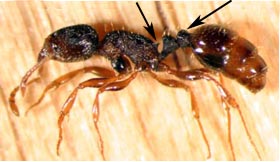 Workers
are slow-moving, 1/10” to 1/8” long, and dark brown
in color. Both the head and thorax have numerous
grooves that run lengthwise. In addition, there is a
pair of spines on the thorax and a sting at the tip
of the abdomen. As their name implies, pavement ants
tend to nest beside and under sidewalks, driveways,
patios, and foundations. The presence of a nest is
often evidenced by a mound of soil around a crack in
pavement. Winged reproductive ants undergo mating
flights in the spring to form new colonies. Pavement
ants feed on dead insects and honeydew. Indoors,
they feed on most types of food, including both
sweet and greasy items.
Workers
are slow-moving, 1/10” to 1/8” long, and dark brown
in color. Both the head and thorax have numerous
grooves that run lengthwise. In addition, there is a
pair of spines on the thorax and a sting at the tip
of the abdomen. As their name implies, pavement ants
tend to nest beside and under sidewalks, driveways,
patios, and foundations. The presence of a nest is
often evidenced by a mound of soil around a crack in
pavement. Winged reproductive ants undergo mating
flights in the spring to form new colonies. Pavement
ants feed on dead insects and honeydew. Indoors,
they feed on most types of food, including both
sweet and greasy items.
ACROBAT ANT
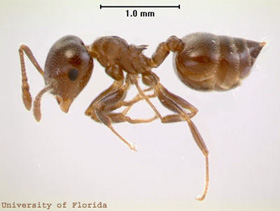 Acrobat
ant workers are 1/16”- 1/8” long and light brown to
black in color. There is a pair of spines on the
thorax and the abdomen is heart-shaped when viewed
from above. This ant gets its name from the fact
that it raises its abdomen over its head and thorax
when alarmed. Acrobat ants nest indoors where moist,
damaged wood is present. Therefore, their presence
in structures may mean a moisture
Acrobat
ant workers are 1/16”- 1/8” long and light brown to
black in color. There is a pair of spines on the
thorax and the abdomen is heart-shaped when viewed
from above. This ant gets its name from the fact
that it raises its abdomen over its head and thorax
when alarmed. Acrobat ants nest indoors where moist,
damaged wood is present. Therefore, their presence
in structures may mean a moisture
problem or water leak is present. In addition, this
ant will nest in abandoned termite, carpenter ant,
or other wood-destroying insect nests. Acrobat ants
may also nest in Styrofoam insulation panels and
wall voids. Often, this indoor nest is associated
with a nest outdoors in a tree, stump, or log.
Workers feed on live and dead insects, as well as
honeydew from aphids and mealybugs. This ant may
invade homes in search of household food, showing a
preference for sweets. When colonies are disturbed,
workers will readily bite and emit a repulsive odor.
New colonies are formed by swarmers that take flight
from mid-May to September.
